Dracula Myth
00:50 Aug 30 2009
Times Read: 6,986
Mitul Dracula - Vlad Tepes REALITATE SI FICTIUNE IN TARA DE DINCOLO DE PADURE
REALITATE SI FICTIUNE IN TARA DE DINCOLO DE PADURE
“Si daca mor, eu ce ma fac”
Datorita numerosilor cercetatori ai fenomenului mitic, s-au elaborat de-a lungul timpului peste 500 de definiti. Noi vom explica pe acelea care ne-au ghidat cercetarea, dar si o succinta trecere in revista a problematicii mitologiei, pentru ca apoi sa formulam o parere personala asupra raportului mit-realitate in umbra caruia vom intelege adecvat semnificatiile Mitului Dracula.
Pentru Mircea Eliade miturile reveleaza structurile realului si multiple moduri de a fi in lume, asadar ele sunt modelul exemplar al comportamentului uman; povestesc istorii adevarate, referindu-se la lucruri adevarate. Nu exista mit, daca nu exista dezvaluire a unui mister, revelatia unui eveniment primordial, care a intemeiat fie o structura a realului, fie un comportament uman. Asadar mitul nu poate fi particular, privat sau personal. De asemenea, considera Mircea Eliade, ca mitul este asumat de om ca fiinta totala, el nu se adreseaza numai inteligentei sau numai imaginatiei.
Pentru Victor Kernbach aflam ca, in urma consultarii unei bibliografi impresionante, mitul este definit a fi o naratiune traditionala complexa, ivita la intersectia dintre planul cosmic cu cel uman, avand continut specific, decantat din vremuri memoriale in forme sacralizate, al carui scop este modelarea explicarii unor fenomene si evenimente enigmatice cu caracter spatial si temporal, care privesc atat natura biologica cat si spirituala a omului, precum si fenomene ale naturii ambiente sau chiar a intregului univers. Miturile ar fi explicatii ale destinului conditiei cosmice si umane, atribuindu-le tuturor acestora origini supranaturale din vremea creatiei primordiale, pe care le considera sacre si revelate de fiinte supraumane.
Vom pleca, totusi, de la o premisa destul de controversata inca in cadrul psihologiei, dar, dupa parerea noastra, verosimilitatea ei a fost in termeni necesari si suficienti dovedita. Este vorba de “teoria arhetipului” ca parte integranta, dobandita filogenetic, a fiintei umane. Consideram, deci ca inca din momentul nasterii, omul poseda o serie de potentialitati, nu este nicidecum o tabula rasa si ca mediul si educatia sunt cele care slefuiesc devenire personalitatii.
Avand in vedere structura organismului, ar fi de mirare ca psihicul sa fie unicul fenomen care sa nu prezinte urme clare ale istoriei evolutiei sale, iar faptul ca aceste indicii sunt in cea mai stransa corelatie tocmai cu substratul instinctual este extrem de probabil. Asadar omul are in sine insusi a priori tipuri de instincte, care constituie modelul activitatii sale. Tot Jung afirma ca aceste arhetipuri sunt parte integranta a fiintei umane, ca intensitatea si frecventa manifestarilor lor nu a suferit dramatic nici o modificare, de-a lungul evolutiei sale de la hoarda primitiva la omul contemporan:”ele nu sunt numai relicve sau reziduuri inca prezente ale unor modalitati de functionare mai vechi, ci regulatori mereu prezenti, biologic indispensabili, ai sferei instinctelor, al caror efect se extinde asupra intregului domeniu al psihicului”. Cu alte cuvinte omul a construit, construieste si va construi dupa un “pattern of behavior”. Toate activitatile sale sociale fie intelectuale, fie de vibrare afectiva, au la baza, la temelie arhetipuri.
Daca dupa cum am vazut functia arhetipului ramane relativ aceasi de-a lungul generatiilor, sa vedem ce putem spune despre continutul sau ideatic. El este considerat a fi un fond de imagini stravechi, ce apartin tezaurului comun al omenirii. Rezulta de aici ca activitatile care isi au fundatia pe arhetipuri sunt eminamente colective, sunt rezultate ale gandirii colective. Arhetipul devine pentru sistemul psihicul uman ceea ce instinctul este pentru omul biologic.
Prin “imagini” nu trebuie sa intelegem simple fotografii interioare, ci reflectii imanente ale unor scheme de comportament, iar faptul ca este comun umanitati conduce la idea ca activitatile care au la fundatie aceste tipuri de comportament sunt constatabile, evident nu direct ci hermeneutic, numai in produsele sociale ale omului, caci cea care le-a conceput este gandirea colectiva.
Gandirea omului nu a ramas neatinsa de evolutie, ea este chiar nota sa definitorie, avand rol determinant in structura bio-psihica actuala. Vrem sa afirmam ca arhetipul chiar daca este un dat ereditar, capata forme de manifestare in functie de gradul de dezvoltare a gandirii, a capacitati acesteia de intelegere si mai ales de a privi mediul inconjurator si pozitia sa in raport cu acesta.
Imediat dupa ce si-a indeplinit trebuintele biologice primare, omul a cautat obtinerea intr-un fel sau altul a securitati, a sigurantei. Nivelul de dezvoltare a gandirii i-a permis sa constate ca toate obiectele amorfe sau lucrate de om, ca si toate fenomenele naturii isi au sufletul, viata si modul propriu de existenta, dupa model uman: cortul are sotie si copii, iar animalele isi au gospodariile si chiar tarile lor propri. La un moment dat in existenta sa a constatat ca cei dragi nu mai pot sa vorbeasca cu el, nu mai “au umbra”. A devenit preocupat de anumite fenomene care i se intamplau si a descoperit sufletul. Considera acum ca sufletul il poate parasi temporar, in somn sau lesin, ori definitiv in cazul mortii. Dupa ce si-a format o reprezentare intuitiva asupra vietii, a devenit constient de drama existentei. In stransa corelatie cu nivelul de dezvoltare a gandirii sale, cu descoperirea ideii de suflet sau de sine, si a constatarii ca natura este mama femeii cu care s-a insurat, potrivnica dorintelor sale, necrutatoare, omul a nascocit ideea de divinitate, prima creatie colectiva a umanitatii.
Divinitatea nu putea fi gandita a fi altfel decat antropomorfa, o abstractizare superioara nefiind posibila. Asemeni lui insusi divinitatea putea fi miscata prin apeluri la indurarea, la sperantele si temerile lor. Daca el insusi putea fi emotionat prin simple rugaminti si daruri, fata de divinitate este nevoie de un anumit protocol, o anumita atitudine si o anumita exprimare. Iata deci ca el a descoperit magia si forma sa de manifestare: ritualul. Intr-un astfel de sistem existential omul primitiv se simtea in siguranta, la adapost, nimic nu mai statea in calea de abia nascutului embrion al vointei de putere, putea nestingherit sa influenteze cursul naturii in propriul sau folos.
Lumea contemporana ii spune acestei conceptii “mit” si o trateaza cu vadita ironie. Sa fie atunci cunoasterea susceptibila de valorizare? Nicidecum! Mitul este reflectia cunostintelor despre lume si viata la care a ajuns omul primitiv, evident naive insa numai in comparatie cu cele contemporane; in sistemul sau de referinta mitul era un adevar indubitabil. Din cele spune de noi rezulta ca si omul contemporan se conduce dupa Mituri, el insa a renuntat sa le mai numeasca asa ci le spune acum Teorii.
In conformitate cu teoria arhetipului si cu cele precizate de noi pina acum se degaja ideea ca atat un studiu transversal cat si unul longitudinal ar trebui sa releveze ideea ca mitul nu este personal sau privat, prin insasi modul sau de a fi. El s-a nascut din arhetip si in consecinta trebuie sa fie prezent intr-o forma sau alta la indivizii umani aflati la acelasi nivel de evolutie, dar si la cei aflati in epoci diferite, evident tinand cont de deformarile si deghizarile pe care le presupune achizitiile culturale specifice.
Studiul transversal asadar, doreste sa dovedeasca ideea ca diferitelor mitologii le corespund personaje care intruchipeaza aceleasi arhetipuri. Pentru a demonstra adecvat aceasta ipoteza vom cerceta un exemplu concret: arhetipul eroului civilizator.
Un astfel de personaj gasim in mitologia mesopotamiana. Este vorba de Oannes, zeu sau fiinta supraumana, mesianica, dintr-un mit sumerian. Ea ii invata scrierea, stiintele si felurite arte. Le arata cum sa-si zideasca locuintele, sa intemeieze temple, sa se foloseasca de legi si de cele mai de seama principii ale geometriei. Acesta faptura i-a invatat pe oameni tot ce putea sa-i umanizeze.
Mitologiile civilizatiilor precolumbiene ne furnizeaza un personaj cu trasaturi asemanatoare. Quatzalcoatl este un zeu aztec care in ipostaza sa umana este mare legislator si aducator de cultura si civilizatie, un rege sensibil, neindurand sa vada suferinta fiintelor si un mantuitor.
Mult mai cunoscut este insa Prometheus, zeu titan in mitologia greaca. Este razvratit impotriva lui zeus, dar prieten al oamenilor, carora le-a daruit focul si ratiunea invatandu-i si mestesugurile esentiale; este totusi, pedepsit de zeus pentru activitatea sa de erou civilizator. Aceste exemple vin sa consolideze ipoteza de la care am pornit.
Cercetarea longitudinala o vom incepe cu lumea traditionala. Imediat dupa constientizarea propriei existente, omul s-a intrebat cum a aparut lumea in care el respira, dar si el insusi. Au aparut in consecinta miturile sau teoriile cosmogonice si dependent de acestea cele antropogonice. Exista astfel de mituri atat la omul arhaic cat si la cel modern? Evident, da!
Omul traditional considera ca s-a nascut in urma unui gest divin, ca intregul univers a existat intr-o forma sau alta inainte ca zeii sa-i dea structura si ordinea pe care o constata astazi.
In ceea ce priveste credintele omului modern lucrurile sunt putin mai delicate. S-au produs intre timp de la omul primitiv pana la cel contemporan modificari semnificative in gandire. Intelegen prin aceasta ponderea gandirii personale, considerata forta motrice, in detrimentul gandirii colective, predominanta in gandirea omului primitiv.
Cum era de asteptat mitul creationist s-a conservat, chiar daca concomitent cu el exista o alta teorie pseudostiintifica la fel de naiva. Este vorba de teoria Marelului Big Ben, a expansiunii materiei din ea insasi.
Dupa ce a rezolvat dilema originii lumii si a sa insusi omul din toate epocile s-a preocupat de modul, de arta de a trai viata. Si s-au nascut astfel tabuurile, eroii civilizatori, sistemele morale si apoi cele etice.
Dependent de raspunsul dat intrebarii privitoare la originea omului s-a nascut cea referitoare la drama existentiala. Se regaseste atat in arhaism cat si in contemporaneitate conceptia existentei postume, a unei escatologii universale, unice sau ciclice, dar si a uneia private. De abia acum din perspectiva dramei existentiale, a inerentei mortii, putem privi si intelege pe deplin sensul ritualului si raspunsul sublim dat acestei probleme de constiinta colectiva.
Mitul nu este forma ultima de manifestare a conceptiei primitive. Acesta odata elaborat naste sacrul ori acesta inspira teama si respect dar si interdictie. In consecinta, cu divinitatea nu se poate comunica oricum ci prin intermediul unor procedee magice, dupa un scenariu riguros, adica printr-un ritual. Acesta este in primul rand o imitare a cosmogoniei sau antropogoniei, a unirii elementelor primordiale, deoarece prin acest act magic s-ar reusii preluarea puterii divinitatii.
Pe de alta parte de corectitudinea si mai ales de efectuarea insasi a ritualului depinde chiar ordinea lumii. Iata de ce era atat de important pentru ciobanul muntean indeplinirea stricta a datinii. Moartea este inerenta conditiei umane, ca de altfel si viata postuma, ori din aceast punct de vedere ritualul care asigura trecerea dintr-o forma de existenta in alta este decisiv. Moartea este privita ca un fel de escatologie personala, iar ritualul de inmormantare devine actul de creatie al unei noi vieti. Rolul ritualului, care descinde din mit, are in cele din urma o functie catharctica, de purificare, alinare.
Intr-o lume in care fiecare activitate sau chiar gest este repetarea unui model exemplar, cu alte cuvinte a unei cosmogonii, notiunea de Timp se estompeaza, el nu mai curge de la sine implacabil si univoc asa cum considera omul modern. Am facut aceasta ampla trecere in revista pentru a indreptati distinctia pe care o vom opera asupra “realitatii”.
Consideram asadar ca exista in functie de raspunsul dat cosmogoniei si dramei existentei o “realitate mitica” si o “realitate istorica”. Deosebirea dintre ele ar consta in faptul ca in cazul celei mitice notiunea de timp nu are sens, consistenta, in timp ce cealalta aseaza la baza ei tocmai trecerea timpului. Daca realitatea mitica considera real tot ceea ce corespunde si isi are originea in sistemul de cunostinte care a generat-o, realitatea istorica este in primul rand concreta, reale fiind obiectele si fenomenele percepute numai pe calea simturilor sau a ratiunii, purificandu-o de orice tendinta afectiva. Realitatea mitica este chiar dimpotriva rezultatul unei dorinte, al unui ideal, devenind reala numai pentru ca este o opera sociala, colectiva.
Cum societatea traditionala aseaza la fundamentul vietii sociale si culturale mitul ca metoda de aparare, evident utopica, in fata vicisitudinilor vietii cotidiene, va imbratisa realitateea mitica. Asa cum au convenit renumiti exegeti ai fenomenului mitic, actele umane, obiectele pe care el le crea, si mediul ambiant in care traia dupa descoperirea religiei, dobandeau consistenta, realitate in masura in care reiterau fie un act mitic, fie erau intruchiparea telurica a unui model, a unui arhetip celest.
Comportamentul constient al omului arhaic nu cunostea acte care sa nu fi fost infaptuite si traite anterior de un altul care nu era om. Ceea ce el facea, a mai fost facut, viata sa fiind repetarea neintrerupta a unor gesturi inaugurate de alti. Gestul nu capata sens, realitate decat in masura exclusiva in care reia o actiune primordiala. Astfel casatoria sau orgia colectiva trimit la prototipuri mitice, fiind practicate pentru ca au fost candva, “ in illo tempore”, consacrate de zei, de stramosi sau eroi. Conchidem ca un obiect sau o actiune nu au valoare autonoma intrinseca, nu-si gasesc realitatea, identitatea decat in masura in care intr-un fel sau altul participa la o realitate care le transcede.
Constructiile amului arhaic nu sunt altceva decat imitati ale unui model extra-terestru. Omul construieste dupa un arhetip. Insa nu numai orasul sau templul sau au modele celeste, dar la fel se intampla cu toate regiunile pe care el le locuieste, cu fluviile, cu campurile care il hranesc. Conform credintelor mesopotamiene, Tigrul isi are modelul in steaua Arunit si Eufratul in steaua Randunelei. Pentru unele popoare muntii au prototip ideal in cer, iar la egipteni numele de locuri si persoane erau date dupa cele din “campurile” celeste. Se desprinde din cele spuse ideea ca realitatea este functie de imitare a arhetipului mitic.
Societatile care au urmat ajungand pana la cea moderna nu au putut ignora admirabilul raspuns dat dramei existentei. Acesta se va mula perfect pe arhetipurile deja primite drept “cadou”, dar va fi influentat de actualul sistem de cunostinte.
Astfel in cazul omului modern se constata coexistenta acestor doua realitati, una fiind in mod necesar transcendenta. La aceasta din urma, cea mitica, omul contemporan se intoarce ori de cate ori realitatea istorica se transforma intr-un veritabil si abil dusman, ori de cate ori ea este incapabila sa ii satisfaca dorintele.
Plecand dar, de la premisa exemplaritatii si universalitatii, ca dimensiuni constitutive ale mitului, scopul lucrarii noastre este acela de a revela Mitul Dracula in primul rand, in functie de criteriul cronologic si nu al popularitatii, ca forma de manifestare specifica secolului al XV-lea, a arhetipului eroului civilizator, si in al doilea rand ca simbol deghizat al dorintei eterne a omului nemurirea.
I
In prima sa ipostaza mitul dracula se identifica cu personajul istoric Vlad Tepes. Dracula s-a nascut in 1431 in Sighisoara, cand tatal sau se afla in exil in Transilvania. Strabunicul lui Tepes, Radu I a avut doi fii: pe binecunoscutul Mircea cel Batran si pe Dan I. Lui Mircea i s-a nascut Vlad poreclit Dracul, iar lui Dan I Dan II. Spita lui Vlad Dracul a primit numele de Draculesti, iar cea a lui Dan I de Danesti. Imediat dupa moartea lui Mircea cel Batran incepe o puternica lupta intre cele doua familii conducatoare care viza ocuparea ocuparea tronului. Dusmania dintre ei a facut ca in mai putin de de 30 de ani Tara Romaneasca sa aiba opt domnitori, si numeroase asasinate intre rude, mai mult sau mai putin apropiate. Despre mama lui Tepes se stie ca era o nobila transilvaneana, careia i-a fost incredintata educatia lui Tepes pana la varsta de cinci ani. Dupa acesta varsta, cand Vlad Tepes a devenit print, educatia sa in special militara, a fost preluata de un cavaler, combatant in batalia de la Nicopole.
In 1447 Tepes se afla la Adrianopole, de trei ani alaturi de un frate al sau, fiind incredintati sultanului ca gest de buna credinta fata de ajutorul primit de Vlad Dracul in ocuparea tronului. Tot in acest an Vlad Dracul cade in disgratiile lui Iancu de Hunedoara, conducatorul Ungariei. Lipsit de protectia sa, careia i se adauga o atitudinea draconica fata de boierime, Vlad Dracul si fiul sau Mircea, sunt asasinati in urma unei conspiratii boieresti.
La aflarea vesti despre moartea lui Vlad Dracul sultanul il elibereaza pe Dracula si il ajuta cu oaste in recuperarea tronului. In 1448 Vlad Tepes ajunge la putere, insa dupa numai doua luni interventia armata a lui Iancu de Hunedoara il obliga sa se refugieze in Moldova, aparat fiind de varul sau Bogdan Voievod, unde ramane timp de trei ani, pana la asasinarea acestuia, in 1451. Intre timp la tronul Tarii Romanesti este urcat Vladislav II.
Scandalul provocat de uciderea lui Bogdan il obliga pe Vlad sa caute protectia dusmanului tatalui sau. Vladislav II tocmai isi schimbase orientarea politica, proturca, ceea ce nu i-a convenit lui Iancu de Hunedoara. acesta accepta alianta cu Tepes si il aseaza voievod vasal peste Tara Fagagasului si Almas. Aspiratiile lui Tepes nu se opresc aici, el asteapta momentul propice, pana in 1456, de a reclama tronul Valahiei.
Imediat dupa caderea Constantinopolului, in 1453, se pregateste o noua cruciada. Intentia s-a concretizat in 1456 cand Iancu de Hunedoara in fruntea unei armate crestine impresionante invadeaza partea Serbiei aflata sub dominatie turca. In acelasi timp Vlad Tepes invadeaza Tara Romaneasca.
In batalia de la Belgrad Iancu de Hunedoara este ucis, iar armata sa invinsa. Intre timp Vlad Tepes reuseste sa-l asasineze pe Vladislav II si sa preia tronul. Victoria turcilor l-a obligat pe Tepes sa adopte o atitudine obedienta fata de acestia, cel putin pana la consolidarea autoritatii domnesti. Dupa ce acest deziderat a fost atins, Vlad Tepes porneste propria campanie de pedepsire a turcilor.
Abilitatile de luptator dar si preacunoscuta sa cruzime l-au facut un dusman redutabil. Incursiunea sa pe teritoriul otoman este vremelnic victorioasa, fapt care atrage fulgerator atentia Papei Pius II. El se hotaraste sa-l sprijine financiar prin intermediul lui Matei Corvin. Ajutorul trimis de papa este retinut de Matei Corvin care tergiverseaza pana la limita momentul implicarii in lupta.
Viteaza dar putin numeroasa armata a lui Dracula se vede nevoita in acesta situatie sa se retraga din fata dusmanului. Turcii pornesc o campanie impotriva lui Tepes reusind sa-l alunge in Transilvania in 1462. Tepes reuseste sa scape de urmaritorii sai refugiindu-se si cerand ajutorul lui Matei Corvin. Raspunsul acestuia a fost intemnitarea, iar dupa o perioada il elibereaza obligandu-l totusi la domiciliu fortat intr-o proprietate domneasca din Buda.
In acesta perioada se sechestrare, estimata de unii autori la patru respectiv 12 ani, Vlad Tepes se pregateste pentru redobandirea tronului, mai ales dupa ce fratele sau Radu cel Frumos a fost alungat de la domnie de catre Basarab cel Batran, membru al clanului Danestilor.
Politica favorabila turcilor adoptata de acesta a determinat reabilitarea lui Tepes, astfel ca in 1476 insotit de osteni transilvaneni si moldoveni, acestia din urma trimisi de insusi Stefan cel Mare, invadeaza Tara Romaneasca si recucereste tronul.
Dupa mai putin de o luna turci pornesc o ofensiva menita a-l reinstala pe Basarab cel Batran la putere. Cu o armata foarte putin numeroasa Vlad Tepes infrunta “armia turcesca”. Rezultatul este infrangerea lui Tepes si moartea sa, in conditii enigmatice, relevate contradictoriu in documentele timpului. Se vehiculeaza ideea ca a fost ucis din greseala de chiar camarazii sai de arme, sau ca a fost decapitat in timpul luptei de un turc deghizat in valah.
Cele prezentate pana aici apartin de realitatea istorica, fiind in consecinta de netagaduit in sistemul sau de referinta. Un argument in plus il constitue folosirea repetata a supraunitati de masura a timpului.
Fantezia unui popor nu este starnita de fapte banale, anodine, ci de cele care il emotioneaza, poate chiar il inspaimanta. Ori aceste fapte sunt chiar actiunile voievodului. Dar noi stim ca atunci cand e vorba de oameni care intr-o imprejurare sau alta, au ajuns vestiti popurul inchipuie despre ei povesti potrivite celor ce el ar fi vrut sa se intample. Povestile sunt prin urmare adevaruri ideale care corespund meritelor acelor personaje in jurul carora poporul le-a creat; si ele sunt uneori false in sensul ca acestor personaje lis-a atribuit capacitatea de a savarsi ceea ce in fapt ele nu sunt capabile sa savarseasca.
Dar nu este vorba de o falsificare deliberata a istoriei. Si pentru a sprijini acesta afirmatie vom prezenta cateva exemple preluate de la Mircea Eliade.
Dieuneonné de Gozon, al treilea Mare Maestru al Cavalerilor Sfantului Ioan de Rodos, a ramas celebru pentru uciderea dragonului din Malpasso. Inutil sa precizam ca lupta nu este mentionata in documentele timpului sau si ca a inceput sa se vorbeasca despre ea abia cand s-au implinit doua secole de la nasterea eroului. A avut loc asadar, cum e si firesc, atribuierea printului de Gozon a virtutiilor Sfantului Gheorghe, cunoscut pentru lupta victorioasa impotriva monstrului. Asadar din simplu fapt ca printul de Gozon a fost integrat unei categorii s-a contopit in arhetip fara sa se mai tina cont de faptele sale autentice istoric.
Marko Krajlevič, protagonistul epopeii iugoslave, s-a facut cunoscut prin faptele sale vitejesti din a doua jumatate a secolului al XIV-lea. Existenta sa istorica nu poate fi pusa la indoiala, cunoscandu-se chiar data mortii sale 1349. Dar odata intrata in memoria populara personalitatea istorica a lui Marko este abolita si biografia sa reconstituita urmand normele mitice. Mama lui este o Vila, o zana, tot asa cum eroii greci erau fiii unor nimfe sau a unor naiade. Sotia lui este tot o Vila pe care el o cucereste printr-un siretlic.
Psihologia a demonstrat ca in timpul conservarii materialului engramat acesta sufera transformari. Printre altele are loc si procesul de reducere a nefamiliarului la familiar. Acesta se caracterizeaza prin faptul ca un material intiparit, insa insuficient consolidat este treptat modificat, prin mecanisme inconstiente de uitare si adaugire, si facut sa semene cu un alt material binecunoscut, evident pe baza unor elemente de contiguitate.
Daca constiinta individuala se confrunta cu o astfel de problema, intr-o perioada net inferioara daca nu chiar incomparabila cu existenta sociala nu trebuie sa ne mire faptul ca memoria colectiva sufera si ea un astfel de proces.
Are loc asadar in cazul personalitatilor istorice metamorfozarea acestora in eroi mitici, in sensul ca acestia sunt “facuti sa semene” cu eroii vechilor mituri. Evenimentul istoric in sine, nu este retinut de memoria populara si amintirea lui nu inflacareaza imaginatia poetica decat in masura in care acesta se apropie de un model mitic.
Amintirea unui eveniment istoric sau a unui personaj autentic nu rezista mai mult de doua, trei secole in memoria populara. Si acesta pentru ca, asa cum am demonstrat, memoria colectiva retine cu greutate evenimentele individuale, figurile autentice. Ea functioneaza prin intermediul unor structuri diferite: categorii in loc de evenimente, arhetipuri in loc de personaje istorice. Personajul istoric este asimilat modelului mitic in timp ce evenimentul este integrat in categoria actiunilor mitice.
Dar sa vedem care sunt faptele si personalitatea voievodului care au intaratat in asa masura fiinta totala a oamenilor, asa cum se degaja ea din scrierile secolului al XV-lea.
In orice caz figura lui Vlad Tepes este cu toata aureola de sange ce o inconjura, una din cele mai interesante ale intregii noastre istorii. Crud pana la maruntaie, strain de mila si de indurare, el a pus cumplita lui fire in slujba tarii sale si dupa ce a curatit-o de relele launtrice, taind si acolo unde ar fi putut lecui, el puse piept injosirii in care cazuse. Acum se arata si celelalte insusiri ale sale: curajul temerar si dipretul mortii, care-l facuse in stare sa infranga pe cel mai mare cuceritor al lumii.
Calitatile dominante care se evidentiaza in personalitatea lui Tepes sunt, in primul rand, orgoliul sau de “mare stapanitor”, urmat indeaproape de inteligenta si simtul crud al dreptatii. Acestora li se adauga trasaturile de caracter cum ar fi : vitejia , dovedita de atatea ori, curajul de a infrunta un inamic abil, cu prestigiu de invidiat.
Privindu-l pe Dracula in ipostaza de mare stapanitor putem a-l apropia cu usurinta de arhetipul mesianic. El este intruchiparea “unsului lui Dunmnezeu”, ale carui acte nu pot fi judecate de oameni. Din actiunile lui putem trage fara dubi concluzia ca Tepes credea cu incapatanare ca a fost pus de Dumnezeu ca stapan pentru a pedepsi pe cei care fac rau si a milostivi pe cei care fac bine, asa cum i-a confirmat calugarul intelept care a si scapat cu viata.
Tot prin intermediul acestei credinte a sa putem explica atitudinea tiranica fata de boieri in general. Teama sa, intemeiata, de alfel, de o noua conspiratie a fost mobilul actiunilor de purificare a constiintei acestora de orice gand de tradare. In cazul in care considera ca nu putea realiza soteriologia sufletelor acestora, intoarcerea pe calea cea stramta si dreapta, ii facea “ fara griji pe lumea aceasta”.
Si episodul petrecut in casa din Buda reflecta aceasta conceptie. Tepes a ucis un slujitor al regelui Matei Corvin care ii calcase casa, chiar daca se afla in treburi oficiale, cautarea unui proscris ascuns in rezidenta sa.
Intelepciunea sa se evidentiaza din episoadele in care Vlad Tepes se confrunta cu diferiti soli. El acuza pe stapanitorii acestora ca i-au trimis oameni nepriceputi si ii trage in teapa pe soli, sau ii acuza chiar pe soli ucigandu-i de asemenea, ca neintelepti fiind au acceptat sa i se infatiseze. O alta intamplare care l-a facut celebru ca “ mare conducator de osti”, si “priceput atat cat se poate in treburi ostasesti”, inca in timpul vietii a fost binecunoscutul atac nocturn asupra taberei turcilor.
Ceea ce a ramas inca si in contemporaneitate, viu in constiinta colectiva a poporului roman ramane modul in care vedea Tepes dreptatea: “…si asa de rau ura raul in tara sa, ca daca savarsea careva vreu rau, fie hotie sau talharie sau vreo minciuna sau nedreptate, acela nu era chip sa ramana viu. Fie ca era boier mare, sau preot ori calugar, sau om de rand, ba chiar daca ar fi avut mare bogatie, nu putea sa se rascumpere de la moarte”. Tot atat de aspru pedepsea el lenea si moravurile usoare, oriunde le intalnea.
Evident anecdota cupei de aur ramane realitate mitica, insa impactul pe care il are asupra constiintei este aparte, tocmai pentru ca moartea domnitorului este urmata de furtul cupei, o simbolizare posibila a izgonirii din paradis, privita ca neantizare a unei realitati dorite.
Observam asadar, ca in timpul domniei, Dracula a impamantanit o serie de reguli privitoare la modul in care viata trebuie traita, ori acesta caracteristica este specifica Eroului civilizator. In cazul in care ipoteza noastra este valida trebuie ca in constiinta colectiva sa se perpetueze, sa se conserve imaginea lui Tepes.
Si iata ca dupa mai bine de 400 de ani, cine altul daca nu poetul nepereche, cu multa dibacie, pentru a augumenta o idee face apel la o reprezentare care sa reitereze o realitate dorita, dar apusa, menita a inflacara fiinta totala a cititorului:
“ Cum nu vii tu, Tepes doamne, ca punand mana pe ei,
Sa-i imparti in doua cete: in smintiti si in misei,
Si in doua temniti large cu de-a sila sa-i aduni,
Sa dai foc la puscarie si la casa de nebuni!”14
In cele prezentate pana acum am incercat sa decelam ceea ce este realitate, fie ea mitica, fie istorica in mitul Dracula al secolului al XV-lea. Fantezia in acest mit se intercaleaza subtil in realitate. Pentru a o dovedi acolo unde este cu adevarat, trebuie sa analizam cu deosebita atentie textele din care procuram informatiile, in primul rand motivatia aparitiei lui.
Referitor la “Povestire despre Dracula Voievod” se stie ca a aparut in perioada in care tarul Rusiei dorea sa-si intaresca autoritatea subminata deseori de nobili tradatori. Intr-un asemenea context este normal ca mesajul pe care dorea sa-l transmita scrierea era al unui domnitor crud dar drept, ale carui actiuni urmareau obtinerea bunastarii intregului popor.
Despre versiunea germana se stie ca a aparut din initiativa si la curtea lui Matei Corvin. Este stiut ca acesta intrase in campanie comuna antiotomana, el fiind purtatorul unor subsidii date de Papa Pius al II-lea lui Vlad Tepes in sprijinul luptei antiotomane a domnitorului roman. In acelasi timp Matei Corvin se afla in dispute cu imparatul Germaniei si regele Poloniei, pentru obtinerea sfintei coroane a Ungariei. Ori acest fapt il facea nedornic sa se aventureze in lupte cu turcii alaturi de Vlad Tepes. Pe de alta parte nu putea sa nesocotesca interesele pontificale, caci el se baza si pe sprijinul important al papalitatii. Iata deci, ca alege sa intarzie momentul acordarii ajutorului lui Vlad Tepes, pana in momentul cand ar fi prea tarziu.
Actiunile sale, neimplicarea in lupta antiotomana, abandonarea aliantelor, inlantuirea lui Vlad Tepes necesitau explicatii diplomatico-politice. Justificarea lor a venit prin invocarea unor fapte exagerate in legatura cu o serie de cruzimi premeditat si injust atribuite lui Dracula voievod. Iata de ce textele germane il infatiseaza pe Vlad Tepes ca un tiran insetat de sange, un degenerat caruia i-ar sta mai bine intr-o camasa de forta.
Dar sa prezentam cateva anecdote despre care cronicile ne asigura ca sunt reale, dar noi stim prea bine ca sunt simple inchipuiri, fata de care, prin uzul ratiunii, alaturi de Gheorghe Sincai exclamam: “inca nu poci crede”, “aceste scornituri numai de ras sunt vrednice”.
Una dintre acestea il infatiseaza pe Dracula ospatandu-se printre hoiturile celor trasi in teapa si ucigand pe unul dintre comesenii care cu suporta duhoarea. Urmeaza apoi, executarea tuturor saracilor si nevolnicilor din tara. De-a dreptul ridicol este episodul in care Tepes intemnitat prinde si trage in tepe, mai mici, soarecii din inchisoare, sau tortureaza pasari. Atfel, nici chiar in inchisoarea fiind, nu renunta la activitatea sa preferata. Tot in aceasta categorie includem alte cateva modalitati de tortura atribuite lui Tepes: oameni ingropati goi pana la buric si utilizati drept tinte. Frigerea, jumulirea, fierberea lor de vii pare iarasi fabulatie.
Cautand informatii in biblioteca virtuala am descoperit materiale infioratoare care prezinta pe langa aceste atrocitati si alte fapte atribuite lui Dracula. Vom considera ca faptele prezentate sunt in mod deliberat concepute pentru ca in caz contrar in masura in care ar denota o conduita patologica s-ar referii mai degraba la persoana care le-a imaginat decat la cea careia ii sunt atribuite.
“Dracula's atrocities against the people of Wallachia were usually attempts to enforce his own moral code upon his country. He appears to have been particularly concerned with female chastity. Maidens who lost their virginity, adulterous wives and unchaste widows were all targets of Dracula's cruelty. Such women often had their sexual organs cut out or their breasts cut off. They were also often impaled through the vagina on red-hot stakes that were forced through the body until they emerged from the mouth.”
Referitor la pedeapsa favorita a lui Vlad Tepes am gasit in literatura de specialitate un fapt inedit. Este vorba despre scrisoarea unui boier de vaza, Neagul, adresata conducatorilor cetatii Brasovului: “ Aduceti-va aminte, cine a inceput sa puie oameni in teapa. Tot pribegii si voi care ati ridicat pe Danul dintre voi…”. Asadar, se pare ca primele trageri in teapa au avut loc in Tara Barsei si nu in Tara Romanesca asa cum se crede, si ca cei care le-au imaginat sunt boierii brasovenii.
Am dovedit in termeni necesari si suficienti ca Mitul Dracula al secolului al XV-lea este pentru memoria colectiva simbol al dreptatii, exponent al luptei pentru libertate nationala, model de curaj si inteligenta dar si de patriotism.
II
A venit acum timpul sa prezentam ipostaza in care Mitul Dracula este mult mai cunoscut. Incepand cu secolul al XX-lea din Anglia pana in Germania si Italia, din SUA pana in Japonia, omul de pe strada, omul cu pregatire intelectula medie, recunoaste in mitul dracula personajul reprezentativ al intregii mitologii europene si nord-americane referitoare la vampirism.
Dar in mintea unei persoane care recunoaste sub numele de Dracula ipostaza legendara a lui Vlad Tepes, se nasc indubitabil cateva intrebari: Cine este nebulosul personaj Dracula ivit in 1897? Cine este cel care l-a nascocit? Cum de a devenit atat de cunoscut?
Dupa cum ne spune chiar autorul sau, Bram Stocker, embrionul vampirului Dracula s-a nascut in jurul anului 1871, cand a aflat de la un prieten al sau, Arminius Vambery, profesor la Universitatea din Budapesta, despre existenta unui voievod in secolul al XV-lea, cu numele Dracula destul de renumit, in special datorita luptelor sale cu turcii dar si din pricina cruzimii, a inteligentei, abilitatii si vitejiei sale.
Noi trebuie sa recunoastem ca singurele lucruri pe care cele doua personaje le au in comun sunt numele si locul in care isi duc veacul: Dracula respectiv Transilvania.
Dar sa vedeam cine este Dracula, personajul romanului omonim al lui Bram Stocker. Contele Dracula este un boier secui care locuieste in castelul sau din Pasul Bargaului, si care planuieste sa cucereasca Anglia, prin puterile sale magice de vampir. Incepe prin achizitionarea mai multor proprietati in Londra, Exeter si Whitby. Jonathan Harker este trimis in Transilvania de biroul de avocatura Peter Hawkins la care lucra pentru legalizarea actelor necesare. Pregatirile contelui erau de fapt pe terminate, si dupa ce a incercat sa faca o prima victima din Jonathan Harker, il regasim in plina actiune la celalalt capat al continentului. Prezenta lui se face simtita prin bizare cazuri de maladii. Vampirul se manifesta pretutindeni noaptea, facand victime de-a valma, printre animalele din gradinile zoologice, in ospiciile de alienati mintal, printre femei. Muscatura lui fatala, ale carui urme se zareau pe gatul victimelor, pricinuiau acestora o epuizare progresiva. Sangele lor era treptat supt, noapte de noapte, de vampirul invizibil. Totul se termina printr-o moarte aparenta, care nu era de fapt decat inceputul unei noi existente, cea de vampir. Un soi de comitet antidracula se va constitui din profesorul Van Helsing, Jonathan Harker, Mina Murray, devenita intre timp Mina Harker, dr. John Seward, Arthur Holmwood, Lord Godalming si un american Quincey P. Morris, ultimii doi fosti aspiranti la mana raposatei Lucy Westenra, victima a vampirului. Membrii echipei vor incepe o dramatica urmarire a contelui, care-i va duce, prin Varna, Galati si de-a lungul Siretului, pana la pasul Bargaului, in preajma misteriosului castel. La apusul soarelui se va angaja cea din urma batalie cu o ceata de tigani, aliatii contelui, acesta fiind surprins si ucis intr-un moment in care noaptea nu ii redase inca puterile teribile. Americanul Quincey Morris va pierii in acesta suprema confruntare, dar Anglia va fi in schimb salvata.
Acesta este in linii marii si subiectul romanului care s-a bucurat de un zguduitor succes chiar daca cititorul proiecta atat personajele cat si actiunea si teritoriul in care ea se desfasura intr-un plan fantastic.
Lovitura de gratie apare dupa aproximativ 70 de ani, cand Raymond T. McNally si Radu Florescu scot de sub tipar “In cautarea lui Dracula”. La sfarsitul lecturii romanului, cititorul nu poate sa nu se intrebe daca Transilvania nu este cumva si ea o tara imaginara. Insa raspunsul la aceasta intrebare este pe cat de neasteptat pe atat de dorit. “Da, Transilvania exista si nu doar ea, chiar Dracula insusi a existat”, vine parca sa spuna acesta carte.
Si iata cum, dupa mai bine de 500 de ani Vlad Tepes renaste in constiinta colectiva nu ca erou civilizator cat ca vampir. Dar totusi, constiinta unui individ care apartine poporului roman il retine pe Dracula din perspectiva simbolurilor mitologice locale ca erou civilizator, alaturi de Traian, Decebal, Stefan cel Mare, iar din prisma simbolismului cvasiuniversal, tocmai datorita caracterului coercitiv al majoritatii si ca vampir.
Nici chiar un neofit in mitologie nu s-ar multumii cu o intelegere superficiala a temei vampirismului. Sa privim asadar, fiinta vampirului in profunzimile ei. Despre vampiri stim ca hrana lor preferata este sangele, preferata dar in aceasi masura si indispensabila. Nemurirea lor este urmarea unei muscaturi intr-o zona erogena, gatul, ori acest fapt ne conduce la ideea infaptuirii cosmogoniei. Semnificatiile profunde nu se opresc aici.
Sangele insa, are o semnificatie, este un simbol aparte. Face parte din arhetipul elixirului vietii vesnice alaturi de pulberea de jad alb extras din Muntele Mi, in mitologia chineza, sau de ambrozie, hrana preferata a zeilor care contine germenii imortalitatii, in mai cunoscuta mitologie greaca. Sangele chiar, il gasim in mitologia ebraica considerat sediul sufletului, sau la greci, care alaturi de Hippokrates au credinta ca sangele este identic cu sufletul. In mitologiile populatiilor africane descoperim chiar un zeu al sangelui Ogivu.
Mai aproape de zilele noastre, in jurul anului 1600 si chiar in Transilvania, o astfel de credinta ca exista un elixir al tineretii vesnice in intruchiparea sangelui, a trecut granitele realitatii mitice si a patruns in cea istorica. Autoarea acestui act a fost “tigroaica carpatina” Elisabeta Bathory.
Ea a ucis peste 650 de fete tinere care “nu gustasera inca din placerile dragostei”, pentru a-si potoli agonia in fata mortii. Ucidea cinci sau mai multe fecioare pe saptamana si se imbaia in sangele lor pentru a ramane “forever young”. Cand a constatat ca sangele tarancutelor nu are nici un efect a apelat la cel albastru.
Iata deci, in vampirism o modalitate prin care omul isi poate satisface aspiratia catre nemoarte. Dar in acelasi timp el este o fiinta morala si nu poate tolera sau mai degraba nu poate accepta fatis aceasta metoda. In consecinta, a proiectat asupra altei fiinte dorinta sa ti a numit-o nemuritoare, ti tot asupra aceleiasi fiinte interdictia si a numit-o demon. Si a fost in acea zi vampirul.
In umbra acestei interpretari putem considera Mitul Dracula a fi o ipostaza travestita a aspiratiei catre nemurire a omului, ori acest fapt sugereaza prin excelenta o realitate mitica.
Analizand destinul spectaculos al Mitului Dracula constatam ca acesta s-a produs ca urmare a unor revigorari.Initial mitul dracula desemna personajul istoric Vlad Tepes contopit in arhetipul eroului civilizator. Prima revigorare, realizata de textele germane si slave, a pervertit esenta mitului adaugandu-i o doza de fictiune. Meritul, daca poate fi numit astfel, este conservarea, totusi in mod falsificat, a imaginii voievodului pana la a doua revigorare realizata sub pana lui Bram Stocker. Mitul Dracula devine acum simbol al dorintei necugetate la nemurire.
Cele spuse despre Mitul Dracula sunt valabile pana la timpul prezent, deoarece in destinul mitului se pare ca se pregateste o noua revigorare. Este vorba de Dracula Park, cel mai spectaculos proiect turistic al inceputului de mileniu care este pe cale sa devina realitate sub marca "Produs in Romania".
(C) 2002
IOVITA NICOLAE-ADRIAN
Source:
http://www.referatele.com/referate/istorie/online17/Mitul-Dracula---Vlad-Tepes-REALITATE-SI-FICTIUNE-IN-TARA-DE-DINCOLO-DE-PADURE-referatele-com.php
Vampire hunting still serious business in Romania22:13 Aug 14 2009
Times Read: 7,025

The cemetery where Toma Petre was buried
How do these things get started? How does a particular region of the world get a reputation for rampant vampirism?
Like most things I am sure there is a completely commonsensical explanation.
This whole thing about vampirism probably all started way back when someone crawled out of a grave at their own funeral and bit the shit out of somebody.
See how easily things can get all misconstrued?
How else could someone make the connection between getting sick and being revisited in the middle of the night by a dead relative hell bent on giving you a blood hickey?
Vampires are pretty common in Romania. Therefore hunting vampires, although technically illegal, is still an accepted part of Romanian life.
For example, people don’t even look twice in Romania if you were to be seen digging up a dead relative, ripping out his heart, burning it to ashes, mixing it in a drink and then drinking it down.
You are saving lives as far as people are concerned.
"What did we do?" pleaded Flora Marinescu, the sister of the vampire and the wife of local vampire hunter Gheorghe Marinescu, the man being charged by local authorities of re-killing Toma Petre. "If they're right, he was already dead. If we're right, we killed a vampire and saved three lives...is that so wrong?"
You’ve got to admit, she has a point.
Evidently when they opened up Toma Petre’s grave he was in his coffin lying on his side with blood all around his mouth.
Gheorghe Marinescu, the vampire hunter that took him out, again, nearly fainted at the sight of that. In fact, he had to get drunk twice and come back two consecutive nights just to do the deed.
Apparently vampires are such a problem in Romania that responsible Romanian parents start teaching their children how to kill them when there are barely old enough to pick up a stake.
A lot of Romanians feel that this sort of re-killing of dead relatives shouldn’t be a matter of the courts. Apparently if you get caught killing a vampire, because they are technically dead already, you could find yourself in jail for up to three years for “disturbing the peace of the dead”.
Which is really a bullshit law because if they (vampires) weren’t disturbing my peace in the first place I wouldn’t be digging them up.
Why is their peace more important than mine?
Romanians claim they don’t have a monopoly on vampires. According to them they are everywhere.
It’s just that in big cities, they pass unnoticed.
I can believe that.
Since the Romanians have such a difficult time with vampires, I am going to let them set the record straight on who they are and what they are about.
According to Romanian vampire hunters, crosses don’t do shit to a vampire. Most vampires are Roman Catholic.
Their faith in God has nothing to do with why they want to drink your blood. They are vampires because a black cat jumped over their grave or because they were never baptized in the Catholic Church.
The only reason you are trying to make a connection between vampirism and a cross is because you are ignorant.
A vampire can always be recognized by how it is lying in its coffin. Most people are buried on their backs with their hands on their chest. If you dig up grandma and she is curled up in the fetal position, on her side or lying on her stomach, then chances are she is a creature of the night.
Another sure give away would be the blood on her lips and around her mouth from her latest feed.
For whatever reason vampires never think to wipe their mouths off on their shirts. They love that freshly cannibalized look.
Last but not least, Vampires always prey on their own families. If people start getting sick in your family for no apparent reason, chances are it’s because grandma or somebody is coming in and paying them a little visit while they are sleeping because they are lonely and they want the company.
"That's the problem with vampires," said Doru Marinescu, a 30-year-old shepherd who is related to the vampire hunter being charged with well…vampire hunting. "They'd be all right if you could set them after your enemies. But they only kill loved ones. I can understand why, but they have to be stopped."
Ok, are you ready? Its about to get hype. Here is the part you’ve been waiting for.
There are only two ways to stop a vampire.
The first is to stick a sewing needle in their bellybutton before you bury them.
Yep, that’s about the extent of it.
I know what you’re thinking. I was thinking it too.
If it’s that easy, I can’t understand why that isn’t just standard operating procedure at every funeral home in Romania, to stick a sewing needle in every corpse that you roll out that door. I know the cost of burying a loved one can be expensive but how much would it be to toss in a complementary sewing needle?
The second way is the off the wall way.
Apparently after a vampire has fed, there is only one way after that to kill a vampire. You have to dig them up once they have returned back to sleep, use a curved haying sickle and remove their heart. You have to then burn it to ash on an iron plate, then drink that shit down after you mix it with water.
Wait. I’m not done.
Don’t freak out but expect the heart of the vampire to squeak like a mouse while it is burning and even try to slide right off the plate to get away from you.
They say the best practice is to take a wooden stake and pin it to the pan so it won’t slide off.
Oh Jesus.
I have never hunted vampires before, but I would like to one day. Remind me not to eat before I go out to kill one though. I think the sight of that heart trying to leap off the plate would be a little too much for my stomach.
What I really want to know is, how does a vampire get back inside its buried coffin every single night? Better yet, once it is in its coffin, how the hell does it get the dirt back on it so that you have to dig it back up just to re-kill it?
Source of the article:
http://www.8bm.com/diatribes/volume02/019/378.htm
From the Order of the Dragon to Dracula21:50 Aug 06 2009
Times Read: 7,057
From the Order of the Dragon to Dracula
an article by C. Rezachevici

Vlad Dracula in a modern sculpture
Dracula House
Sighisoara - Romania
The name “Dracula” has witnessed periods of both brilliance and fame. It became famous in the second half of the fifteenth century through the actions of Vlad Tepes (Dracula), ruler of Wallachia (1448, 1456-1462, 1476). It has continued to exist, although less known, through his legitimate descendants, the noble family Dracula of Sintesti and of Band, established in Transylvania between the fifteenth and seventeenth centuries. Families that originated from Vlad’s marriage to a close relative of the Hungarian King Matias Corvin in February of 1462 can provide an explanation of the Szekely ancestry wrongly attributed to Vlad Tepes and his literary metamorphosis the vampire Count Dracula. As a result of the novel of Irish writer Bram Stoker, the name “Dracula” has obtained universal fame during the modern epoch.
The origin of the name “Dracula” has a very interesting history, very different from what has been commonly believed. For a long time, many theories have existed about its genesis, ranging from the claim by Grigore Nandris that it was the genitive Slavonic form meaning “the son of Dracul” (Vlad Dracul was the ruler of Wallachia from 1437-1442 and 1444-1447) to the false connection with a coincidentally similar Romanian word “dragulea”, meaning the dear one or lover. All these theories are connected to the starting point of this name exclusively for Vlad Tepes, until this popular name, meaning “son of Dracul” became confused with the Romanian word “Dracul”, meaning “the devil” (Andreescu 149-50).
To clarify matters, Dracula (Draculea) has represented from the beginning a new popular Romanian form (from the name Vlad Dracul) applied to Vlad Dracul’s famous son Vlad Tepes (Andreescu 156, Stoicescu 201), while the nickname given to Vlad by the Turks was “Tepes”, the Romanian word for impaler. Even before Vlad Tepes’ reign in Romania, the boyar Albu had called Vlad Dracul (which was a nickname known outside of Romania), simply Draculea (Andreescu 150-51), the popular exclusively Romanian name. The Venetian messenger Bartholomeo de Jano and his contemporary Greek chroniclers Leonicos Chalkokondyles and Critobul of Imbros have also called him Draculea (Andreescu 154-55). Even Iancu of Hunedora, who executed him, made mention on December 17, 1456, of “infidelem Drakwlam wayvodem” (Documenta 461). In the end, the Turkish chronicler Asakpasazade, referring to the year 1442, calls Vlad Tepes “Dracula” instead of “Draculea” (Cronici 88), while the Serb janissary who wrote from 1496 to 1501, called him “voievodul valah Dracula” (Calatori 125), which in English means the Wallachian prince Dracula. It is clear that Draculea (Dracula) was a popular nickname for Vlad Dracul, meaning a person belonging to the Order of the Dragon. For his son, Vlad Tepes, the name “Dracula” became through affiliation an alternative, not only a nickname, with the side effect of increasing his bad reputation, with its diabolical meaning, even though originally, in his father’s days, “Dracul” did not have a malevolent meaning.

Sigismund of Luxemburg
King of Hungary and Holy Roman Emperor
Vlad (the father) had obtained the nickname “Dracul” in connection with his receiving the Order of the Dragon from Hungary’s king Sigismund of Luxembourg, at Nürnberg around February 8, 1431. The German name for this order was “Drachenordens,” and in Latin “Societatis draconistarum.” The Order of the Dragon, which some confuse with a decoration, was really an institution, just like the other chivalric orders in medieval times. As a model, Sigismund of Luxembourg took the Order of St. George (Societas militae Sancti Georgii) created by the king of Hungary Carol Robert of Anjou (1308_1342) in 1318. Its statute from 1326 requires the protection of the king from any danger or plot against him; the symbol of the Order of the Dragon was a red cross on a silver field and a black mantle. With the exception of the last object, these are also found in the new order.
In a battle with the anarchical Hungarian nobles and in the background of the other battles for the possession of Bosnia, Sigismund of Luxembourg and the queen Barbara Cilli created the Order of the Dragon on December 12, 1408, mainly meant to protect the king and his family, with the help of a big part of the Hungarian nobility, led by the families of Gara and Cilli. The statute of this Order of the Dragon, elaborated by the chancellor of the Hungarian court, Eberhard, bishop of Oradea, maintained only in a copy from 1707 and published in a Hungarian edition in 1841, has remained almost unknown, even to the investigators of this problem. The analysis of this important document shows that the order aimed at defending the cross and at the destruction of its enemies, symbolized by the ancient Dragons (Draconis tortuosi) with the help of St. George. The battle was against the Turkish pagan armies and the husits, who were outside the Orthodox nations who were faithful to the cross and to King Sigismund (Romanians etc). Barons, priests and leaders of the kingdom gathered below the sign of the dragon, submitted to the cross and proclaimed loyalty to King Sigismund and the queen. The members who founded the order were 24 nobles of the kingdom, led by the despot Stefan Lazarevici, the leader of Serbia, among whom were Nicolae of Gara, the Hungarian prince, Stibor of Stibericz, the prince of Transylvania, Pipo of Ozora, the Ban (local ruler) of Severin etc, in general great local noblemen. They were all engaged in serving with loyalty no matter the price, the royal couple, their family and their friends.

"Serpens" with the cross on it`s back
the first phase of the Dragon Order symbol
The symbol of the order was, after the statute of 1408, a circular dragon with its tail coiled up around its neck. On its back, from the base of its neck to its tail, was the red cross of St. George, on the background of a silver field. According to the first Medieval encyclopedist, Isidor of Seville, it was a “serpens,” a dragon that lives on land.
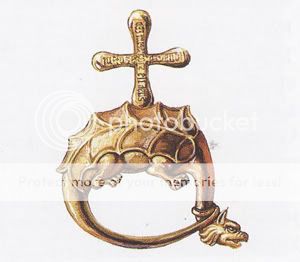
The Symbol of the Dragon Order
the second phase
Justus et Pius
As the years went by, the Order of the Dragon expanded, including two classes, a superior one, whose symbol was a dragon being strangled with a cross stretched out on its back, which, especially from the late fifteenth century to the seventeenth century surrounded a family coat-of-arms. Sometimes foreign members were allowed in, but only as allies, who did not have to take the oath of eternal loyalty to King Sigismund of Luxembourg, for example, the king of Poland, Vladislav Jagiello, his former brother-in-law Vitautas (Witold), the great duke of Lithuania, King Henry the fifth of England, the members of the Italian families Carrara, della Scala and leaders of Venezia, Padova and Verona. During the life of King Sigismund, from 1408 to 1437, the Order of the Dragon became the most important noble political association in Hungary, loyal to the king, the main political force in the kingdom, second to the king. Immediately after being established, it served as a model for the setting up in 1409 of the Spanish order of Calatrava. Into this prestigious European chivalic institution, which was symbolized by the dragon, was admitted the aspirant to the Wallachian throne, Vlad (Dracul) in February 1431, in his position of vassal of Sigismund of Luxemburg, according to the statute of the Order.
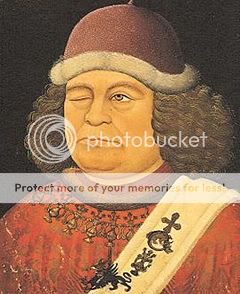
Oswald von Wolkenstein
bearing the sign of the Dragon Order
1432
Admission was into the superior class of the order. The symbol of this class evolved up to 1431 in two phases: the first one, as it has been reminded earlier, was a dragon with a cross drawn on his back, between its wings, from the base of the neck to its tail and lasted from 1408 to 1418; the second one, until the death of Sigismund of Luxembourg, was completed with another cross perpendicular to the coiled up dragon, having on the equal sides of the cross the writing “O quam misericors est Deus” (vertical) and “Justus et paciens” (horizontal). This sign was worn on a sash, like in the portrait of Dichters Oswald von Wolkenstein in 1432.
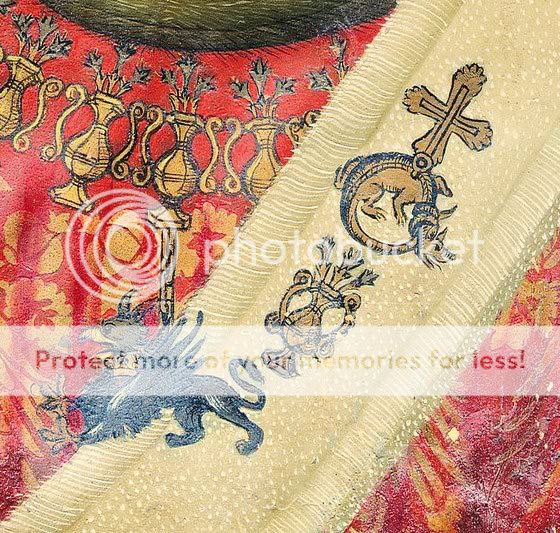
detail from Oswald von Wolkenstein portrait
The necklace of the order was made of two gold chains joined by the sign, a Hungarian cross with a double bar above the coiled up dragon. But on the seal, another dragon was represented, with a big body, with dented wings, not coiled, only two feet with a free tail, with a very small Greek cross on its chest. Sigismund of Luxembourg himself introduced in 1433 the seal for the Order of the Dragon of this type, one of the last seals he made as a Roman-German emperor. Unfortunately, the symbol that Vlad Dracul had wasn’t kept. But the elements of the symbol of the Order of the Dragon on his royal seal of 1437 clearly show that Vlad Dracul was the possessor of the Order of the Dragon necklace: the Hungarian double cross, instead of the Latin cross; the dragon illustrated on the reverse of the six silver and bronze coins that were beat by Vlad at Sighisoara in Transylvania (or after his occupation of the Wallachian throne) is similar to the dragon in Paolo Uccello’s picture, St. George and the dragon; and the coat-of-arms from the episcopacy built by him at Curtea de Arges. Furthermore, he transformed the dragon from the seal to his personal coat-of-arms, not directly but as an original heraldry composition. This coat-of-arms was carved from stone, and represented the dragon attacking a lion, the headed snake, the dragon, emerging victoriously from this battle, therefore illustrating metaphorically Psalm 90 (“You will step on lions and on vipers and walk over lion cubs and snakes”). This phrase’s purpose was to symbolize the victory of Christianity and that of Vlad Dracul over his enemies. In this case the dragon was a benefic symbol, and the picture of Vlad with his name (Dracul, Draculea-Dracula) had a positive meaning which was only common in Wallachia during his reign.
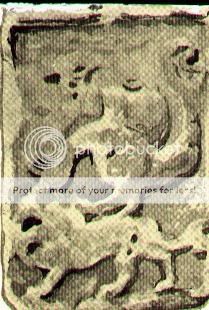
Carved stone with the coat of arms of
Vlad Dracul
Curtea de Arges - Romania
The spreading of the image of the dragon by Vlad Dracul through the large circulation of seal, small coins and heraldic stone carving had a powerful impression on its Romanian subjects. This was increased by the Order of the Dragon necklace, which no other Romanian ruler had worn, and even more so the ceremonial costume of the Order of the Dragon knights - red garments and green mantle. Thus, Vlad Dracul, the father of Vlad Tepes, has forever remained in a bond with both versions of his nickname. This paradox has been interpreted incorrectly.
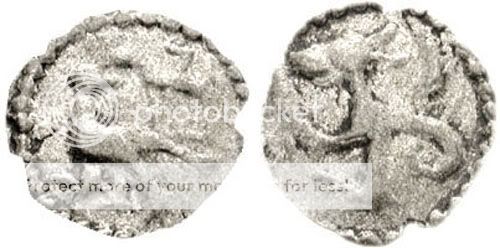
Coin of Vlad Dracul
avers - the eagle(heraldic symbol of Wallachia)
reverse - Dragon
The dragon of the order with the same name was not an evil element during the fifteenth century, but a positive symbol of knighthood. The dragon choking itself with its own tail, which in Occidental St. George heraldry and iconography, from where it originates, represented the defeated Satan, becomes, in the absence of the saint and of the cross, a Christian chivalry order of positive significance. The circular dragon, strangled by its own tail, is represented on the coat-of-arms of many noble families in the Hungarian kingdom who were the descendants of some of the knights who were part of the Order of the Dragon during the reign of Sigismund, until the seventeenth century. This supports the fact that the Order of the Dragon enjoyed great prestige throughout the first half of the fifteenth century. In Transylvania, it also appeared in the coats-of-arms of the families Bathory, Bocskay, Bethlen, Szathmary, Rakoczi and many others, even though the Order of the Dragon had lost its importance after the death of Sigismund of Luxembourg in 1437 and it practically disappeared with the demise of the members who had been admitted by him.
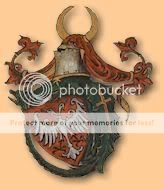
Lazarevici coat of arms with the coiled dragon
Over five millennia of the dragon’s universal existence, it went through many transformations until the fifteenth century and it was known as a fabulous creature, sometimes with the head of a vulture, other times like the animal represented on the Order of the Dragon, with the body of a snake and the wings of a bat. The European Dragon had a lot of sources: Greek mythology (dracon), Roman_Greek tradition, Celtic mythology, the Bible, the Apocalypse, the lives of saints and Oriental influences. During pre-Christian times, the dragon often had a beneficial meaning (often connected with fecundity) and perpetuated in folklore until the late Middle Ages. However, in literature, culture and clerical Christianity, starting from Bibical text, it takes on a different role, and in the fifth century it becomes a symbol of Satan -- “draco iste significat diabolum” (Le Goff 58). This dragon, identified with Satan, was defeated and was dominated by spiritual forces but was not killed; rather, according to the symbolism of Celtic folklore, at some extent, “they even became allied with it” (Le Goff 45), by numerous saints and bishops of the Occident. In the art of Roman influence, the crutch of the bishop often has a defeated and twisted dragon at its tip. Both St. Michael and St. George, whose cult began to spread from the Bizant during the eighth and throughout the tenth, and respectively eleventh centuries, defeated the dragon physically in a fight.
In Occidental heraldry, the physical strength of the dragon was said to have been in his head, but also in its big and strong tail, which in the nineteenth century was considered the illustrative element of the dragon. All this European clerical and folklore heraldry, strengthened in a millenary existence (from the fifth century to the fifteenth century) can be identified in the basic illustration of the Order of the Dragon, the snake-like dragon that is strangling himself with his own tail, which, according to tradition, is twisted three times around the dragon’s neck, signifying that he had been subdued by means of Christian spiritual powers, and the dragon with big paws and wings was the symbol of the one who was defeated by the Saints Michael and George. However, we must also remember the fact that, despite the fact that it had been defeated and subdued, the snake-like dragon and the flying dragon still were evil and the symbols of Satan.

The ancient Dacian flag : draco
the body of a snake with a wolf head
Emperor`s Trajan`s Column - Rome
In the Romanian space to which Vlad Dracul and his son Vlad Tepes belonged, the dragon, named “balaur”, a thraco_dacian word, or “zmeu”, a slavonic word, had its roots in geto-dacian antiquity, whose military flag was representing a snake with the head of a wolf, included the large category of dragons used as flags, which one finds from the times of the Greeks and Romans until the fifteenth century. This divinity represented on the “geto-dacian” flag, became known in the time of the Roman ruling of Dacia as “draco” (in Romanian “drac” (meaning devil). Along with Christianity, it spread all throughout Europe, and came to symbolize Satan. However in pagan terms, as the Romanian historian Vasile Parvan observed, “out of all the Romance languages, the Romanian language was the only one in which ‘draco’ has the meaning of an evil spirit, demon or devil, whereas in others, the word only has the meaning of snake or dragon” (228-30). In Romanian folklore, even the snake, which in certain conditions, has the ability to turn into a dragon, has a strong malefic meaning.
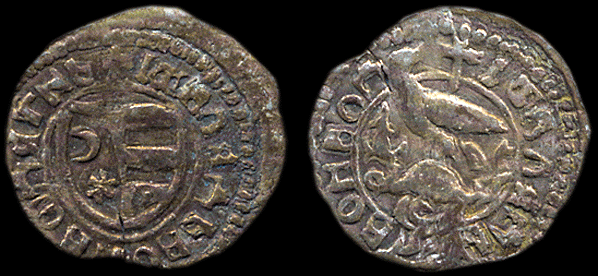
Another coin of Vlad Dracul
Wallachian eagle with the cross on it`s beak
killing a dragon
If “Dracul” and “Draculea” have a positive meaning in connection with the Order of the Dragon during Vlad Dracul’s time and later on during Vlad Tepes’ reign, the same words have an exclusively negative, diabolical meaning, synonymous to the Romanian word “dracul” (the devil), without doubt in connection to the bloody and law-enforcing character of Vlad. In 1459, the aspirant Dan III, accused his rival “Draculea” (Vlad Tepes) of collaborating with the Turks, aided and guided by the devil (Tocilescu 71-2), and in 1460 mentioned “the law-offender and barbaric tyrant, unfaithful and the devil that is Vlad Voievod” (Harmuzeki 53). During Vlad Tepes’ captivity in Hungary (1462-1475), the representative of the pope in Buda, Nicolaede Madrussa, declared that he saw “their tyrant Dracul, a name which they [Romanians] use for the Devil” Papacostea (164). In 1486, the author of the Novel about Dracula voievod, translated in Russian, referred to “Dracula in Romanian, and in our language - devil, that’s how evil he was” (Panaitescu 200, 207).
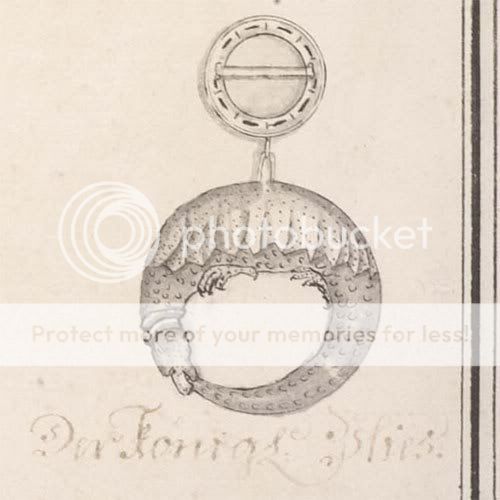
Austrian copy of a lost object found
inside Emperor Sigismund`s tomb
Although Vlad Tepes and his descendants have never used the symbol of the Order of the Dragon, he has inherited the nickname of his father Draculea/Dracula, which has become a family name (outside the country). And his successors in Transylvania, the Dracula (Draculea) family kept this name until the seventeenth century, settling in the sixteenth century among the “secui,” not far from the place where in 1897, Bram Stoker, located the setting of his novel and the Transylvania castle of “Count Dracula.” This way, over a long period of time, from the name of a small pagan deity (Greek, dracos, Latin draco), by means of the name of the Order of the Dragon (in German Drachenordens, Latin Societas draconistarum) to the fifteenth century Romanian nickname of Dracul/Draculea from which the nickname and then the family name, Dracula, comes and was used in 1897 by Bram Stoker, at the suggestion of the Hungarian Jewish orientalist, well known scholar of his time (Florescu & McNally 142-3).
If the Order of the Dragon did not exist, with all its symbols and its being awarded to a Romanian Ruler, the name “Dracula” would not be famous today.
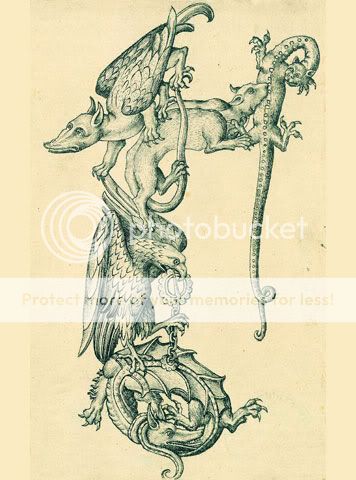
Old drawing with the Dragon Order heraldry
Works Cited:
Andreescu, Stefan. Vlad Tepes (Dracula) intre legenda si adevar istoric. Bucharest, 1976.
Calatori straini despre tarile romane. Bucharest, 1970.
Cronici turcesti privind tarile romana. Bucharest 1966.
Documenta Romaniae Historica. Bucharest, 1977.
Florescu, Radu & Raymond McNally. In cautarea lui Dracula. Bucharest, 1992.
Harmizachi, Eudoxiu. Documente privitoare la istoria romanilor. Bucharest, 1911.
Le Goff, Jacques. “Cultura ecleziastica si sultura folclorica in evul mediu.” Pentru un alt evmediu, II. Bucharest, 1986.
Nandris, Grigore. “A Philological Analysis of Dracula and Romanian Place-names and Masculine Personal Names in -a, -ea.” The Slavonic and East European Review. 36 (1959): 370-77.
Panaitescu, P P (ed), Cronicile slavo-romane din sec. XV-XVI publicate de Ion Bogdan. Bucharest, 1959.
Papacostea, Serban. “Cu privire la geneza si raspandirea povestirilor despre factele lui Vlad Tepes.” Romanoslavica 13 (1966).
Parvan, Vasile. “Contributii epigrafice la istoria crestinismului daco-roman.” Studii de istoria culturii antice. Bucharest, 1992.
Stoicescu, Nicolae. Vlad Tepes. Bucharest, 1976.
Tocilescu, Gr G. 534 documente istorice slavo-romane din Tara Romaneasca si Moldova pirvitoare la legaturile cu Ardealul 1346-1603.Bucharest, 1931.
You can find the article
here
If you liked my information please go and give it a high rate in the VR database
here.
The pictures were added by Dragonrouge.



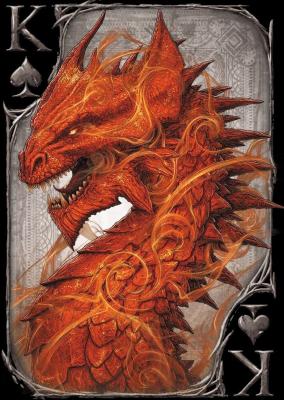
























COMMENTS
-